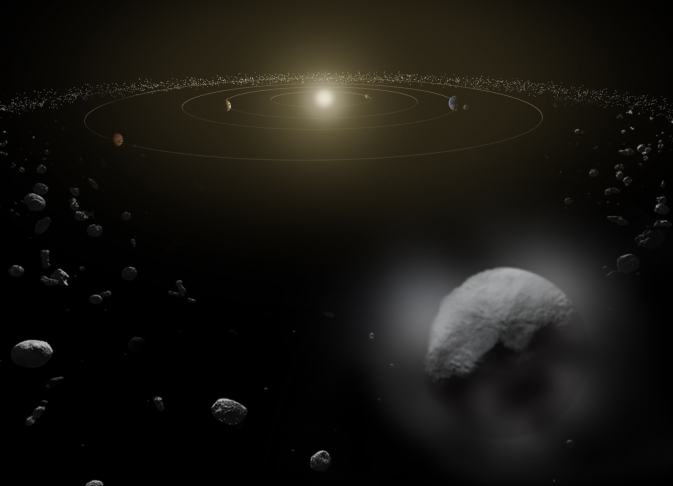

Cheer up Ceres! Dawn is on its way… (Sidenote: I’m sure Ceres doesn’t really have a face on its surface, just commenting on what appears to be a white eye and a frown in this particular view of it). Over the next several weeks, as NASA’s Dawn spacecraft closes in on Ceres before officially inserting itself into orbit on March 6, our view will continue to improve. Until then, researchers are trying to predict what sort of surface features would produce the white “eye” we see in this gif.
The latest image from shows the dwarf planet 27 pixels across, about three times better than the calibration images taken in early Dec, and about 80 percent as clear as Hubble’s images. These preliminary images of Ceres are the first in a series that will be used to help navigate the probe prior to orbital insertion, whereby Dawn will spend a total of 16 months orbiting Ceres — the largest body in the main asteroid belt.
Previously, Dawn orbited Vesta — an object roughly 326 miles (525 kilometers) across — from 2011 to 2012. As the second largest object in the asteroid belt, Vesta was classified as an “asteroid”, until Dawn came along. Thanks to the observations made possible by the Dawn mission, researchers realized that Vesta is unlike any other asteroid we’ve encountered. It is in fact, not even an asteroid at all, but perhaps a protoplanet.

Protoplanets are essentially “baby” planets that have not fully developed yet. In the case of Vesta, its development was interrupted and it was unable to grow any larger. In fact, the Vesta we see today is likely smaller due to the number of impacts it has endured. Vesta’s cessation in development is likely due to the neighboring gas giant, Jupiter.
As the massive planet formed, its intense gravity disrupted the orbit of the other bodies within the asteroid belt, causing them to smash into each other. Evidence of this cosmic “crash-o-rama” can be seen by looking at Vesta’s heavily cratered surface. Scientists determined Vesta contains an iron core, much like the one in the center of the Earth; However, due to multiple collisions over billions of years, Vesta was unable to fully form into a rocky world like the Earth or even Mars.
Until the arrival of Dawn, researchers predicted Vesta to be a very dry and inhospitable world complete with very little atmosphere. As a result any water that would have been on the surface of Vesta would evaporate almost immediately. However, new data from Dawn indicates there may have been short-lived water flows on Vesta’s surface.
“Nobody expected to find evidence of water on Vesta. The surface is very cold and there is no atmosphere, so any water on the surface evaporates,” said Jennifer Scully, postgraduate researcher at the University of California, Los Angeles. “However, Vesta is proving to be a very interesting and complex planetary body.”
During Dawn’s orbit around Vesta, the little probe showed Vesta’s complex surface geology very similar to that of rocky planets. Researchers mapped impact craters that are billions of years old, with newer craters detected inside the older ones.

A new study being published in the journal “Earth and Planetary Science Letters”, by Scully and her colleagues, shows a number of young craters containing curved gullies and fan-shaped deposits on Vesta’s surface. The curvature of the gullies is particularly interesting to researchers, as they indicate the presence of surface water and vary significantly gullies formed by the flow of dry materials.
“We’re not suggesting that there was a river-like flow of water. We’re suggesting a process similar to debris flows, where a small amount of water mobilizes the sandy and rocky particles into a flow,” Scully said. “These features on Vesta share many characteristics with those formed by debris flows on Earth and Mars,” Scully said.
These narrow gullies span 100 feet (30 meters) wide, and just over half a mile (900 meters) long. Some of the best examples of curved gullies can be found within the Cornelia Crater, a surface crater stretching 9 miles (15 kilometers) wide.
Based on this data, it is believed that Vesta harbors small, localized pockets of subsurface ice. The origin of the ice is currently unknown; however researchers suspect these icy pockets could be a result of impacts with comets or other ice-rich bodies. Subsequent impacts would form another crater, with the heat from impact melting some of the ice, and causing it to flow down the crater walls.

“If present today, the ice would be buried too deeply to be detected by any of Dawn’s instruments,” Scully said. “However, the craters with curved gullies are associated with pitted terrain, which has been independently suggested as evidence for loss of volatile gases from Vesta.”
As the water flowed down the crater walls, it would push sand and other rocky particles along, carving out the surface gullies and producing fan-shaped deposits once the water evaporated. The particles help to slow the rate at which the water evaporates. Craters containing curved gullies, like the Cornelia Crater, tend to be only a few hundred million years old, in comparison to Vesta, which is estimate to be 4.6 billion years old.
“These results, and many others from the Dawn mission, show that Vesta is home to many processes that were previously thought to be exclusive to planets,” said UCLA’s Christopher Russell, principal investigator for the Dawn mission. “We look forward to uncovering even more insights and mysteries when Dawn studies Ceres.”
Data collected from Dawn’s visible and infrared mapping spectrometer and gamma ray and neutron detector indicates that there is hydrated material within certain surface rocks on Vesta, a good indication the world is not completely dry. Experiments conducted at NASA’s Jet Propulsion Laboratory (JPL), indicate that there could be enough time for curved gullies to form on Vesta before all of the water evaporated.
(Ceres Rendering, Credit: ESA/ATG Medialab)